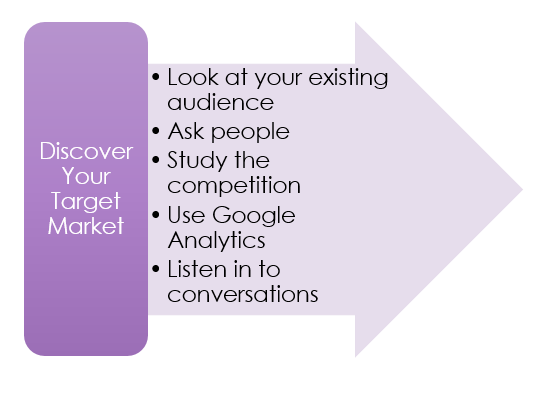Welcome to
Engage and Attract your target audience with visualsCreate & use visual content to explode your business
Module One:
Identify the Visuals that Resonate
What makes or breaks the effectiveness of your visual content is how well it resonates with your audience. Badly chosen or produced content doesn’t hit the mark. Take a look at the types of content your friends and connections share on social media. What made them share it? They identified with the image, either with its sentiment or some other aspect of it.
Your goal with visual content should be to create or choose visuals that tap into their emotion or which they feel a connection to. In order to know what will engage, you have to understand your audience well.
Learning About Your Audience
There’s a good chance that you’ve already done the work here in identifying and learning about your target audience. Businesses often create target market personas to use in their marketing. This persona identifies demographic and psychological information about a business’s optimal potential customer so that the business can choose the right ways to reach them and build a relationship with them.
This is an extremely useful process and, if you haven’t done it yet, it’s in your best interest to create an audience profile. For our purposes in this course, we won’t create an entire profile, but just get to know your audience well enough so that you can choose the right visuals for them.
Start by figuring out where your audience hangs out online. Where does your ideal audience member consume visual content? This could include certain websites, blogs, eZines, forums, or other websites where people consume content. It will definitely include social media, but which social media sites?
As we said, we’re not going to create a complete audience profile for all aspects of your business. For our purposes here, let’s create a simple persona. Try to imagine what type of person is your ideal follower. Identify some demographic traits and their basic attitudes toward the internet and what they do online. Your goal is to find this person online and identify where they consume visual content.
It’s possible that you could have more than one target audience type. For example, your target might be small business owners and freelance service providers. If it makes sense, break up your audience into specific categories. Try to establish buckets based on the content they might consume. If your market has two somewhat different categories, like new grandparents and millennials, you could separate them.
How to Discover Your Target Market
You might be able to make a good, educated guess as to who your audience is. But it’s even better to use actual data to create your audience persona. Here are some ways to do this.
- Look at your existing audience. If you already have followers on social media, customers at your offline store, subscribers to your online newsletter, and so on, look for patterns among these people.
- Ask people. Ask people directly or conduct surveys through whatever communication channels you use with your current audience or customers. Create a short survey asking about visual content consumption habits and offer an incentive to boost your response rates.
- Study the competition. Look at similar companies or companies that offer similar products to you and see what they’re doing online. Look particularly at how their audience interacts with their visual content.
- Use Google Analytics. Check out which pieces of visual content on your site or blog get the most views. Discover how people are finding you and where they’re coming from.
- Listen in to conversations. Find online forums or social media groups for people in your niche. See what other sites or places online they’re talking about.

Choosing Visual Content that Resonates
Once you find your target audience online, follow them and take note of what type of visual content they like. Develop a visual profile that defines what they like and what resonates with them.
For example, you might find that your target audience are relentless meme sharers on social media. Looking at the memes they share, you might find that most are humorous, making jokes about their everyday lives. This is a good starting point for the type of content you can share, and you should note this on their visual content profile.
When creating this visual content profile, the most important metric to look at is engagement. Engagement refers to liking (on social media), sharing, and commenting. The great thing about social media is that it gives you the metrics directly. Under each piece of content, it tells you exactly how many shares or comments a post gets. Look at these numbers and note them on your profiles.
You can do the same with your own site. Post visuals and see which get the most views through Google Analytics. Post various types of visual content on social media and see which get the most engagement.
For this trial content, you might make a few categories, such as “infographics,” “humorous memes,” “inspiring quotes” and so on. Or you could choose other qualities such as “text-heavy,” “text-light” or “no text.” You could classify by what emotions the content inspires, how complex its design elements are, and so on.
Research Competitors
When trying to discover exactly what visual content your audience likes, your competitors offer a goldmine of information. You should spend some time following your competitors and seeing what they create and share, and how their audience reacts to it.
Choose competitors that have been around for a while sharing content and interacting with their audience. Try to choose competitors that have a large and engaged audience.
Look at your chosen competitors’ websites, blogs, ads, social media profiles, sales pages, reports, slide shows, and anything else you can find that has visuals. Sign up for their email newsletters, follow them on social media, subscribe to their blog feeds, and so on. Spend some time monitoring them.
Following your competition can give you great ideas. You can learn from them what kind of content resonates with your shared audience. But the goal here isn’t just to copy them. You’re trying to get a feel for your audience.
You should also be searching for ways to set yourself apart from the competitor in a way that’s in keeping with your brand. Try to find ways to make your content slightly different. For example, you might have a bigger, more mainstream competitor that shares content that is “safe” but rather impersonal. Your brand is edgier, so you can set yourself apart by sharing more controversial visuals, or visuals that are more custom-tailored to your audience.
Activity:
- Using the worksheet, create a visual profile of your target market. Include:
- Where your audience views visual content online
- The types of visual content your audience prefers
- Find some examples of visual content that have been produced by your competitors.
- Make notes on what you like and don’t like about their content.
- Note what you could do to make your visual content different.
A Word
From Tamara
” In spite of how many times you’ve thought it—or even said out loud—“I’m only human,” Discover Your Superpowers: The Key to Unlocking Your True Potential will forever change the meaning of that phrase, “only human.” Discovering and igniting your dormant superpowers will allow you to live your best life. “



